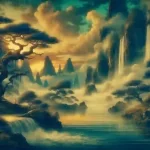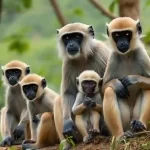Homen Borgahain, on the other hand, wrote some of the most interesting poems during this decade. His individuality lies in his introspective gaze, his almost mystical probing into the mysteries of life and death and his ability in using symbols in a modern way. Borgahain appears to fall in line with D.H.Lawrence in certain aspects of his poetry, though some of his poems which record a romantic nostalgia for the rural, idyllic part do not come under this category Borgohain has shown his modern sensibilities in poems such Smriti, Rati, Sap, and Ratir Prarthana.
Another poet, Bireswar Barua could show a refreshingly precise use of imagery in a few imagist poems such as Diary and Bohag. Continuing his poetic pursuits during the next two decades, Bireswar Barua earned critical acclaim for this poem, Lilyr Abeli in which the poet successfully uses the evocative technique to unravel the disillusionment and sadness underlying the life of an imaginary persona.
The fifties also brought to light two promising poets-Prafulla Bhuyan and Sushil Sarma. While Bhuyan’s poems like Nirjanata, Haitoba Akou Edin remind us of Jibonananda’s post Rabindra lyricism and neo-romantic qualities. Sushil Sarma will be remembered for one or two successful imagistic poems in the Chinese imagistic tradition like his Jonak Ratir Arati.
Hem Barua and Mahendra Bora continued to write poems during the decade. While Mahendra Bora’s poems of this period were marked for sentimental effusiveness and verbosity, his later poems, particularly those included in his latest personal anthology Rupar Tilingar Mat, though still carrying the lilting tone of his earlier poems, show a remarkable transition to a freshness and authentic personal utterance in the moving assertion of the poet’s belief in the values of human love and a personal realization of the eternal, sad music of humanity in concrete terms. In the poems connected with experience at Gauhati Medical College Hospital, one also bears persistent note of sadness associated with decay and death.
Another notable poet of the fifties, Dinesh Goswami, who has continued his poetic creations through the subsequent two decades, has given expression to his acute sense of death and decay, and the ugliness of modern urban life. A pervasive sense of painful alienation and inner conflicts seems to be the dominating note in his poems.
Another poet of the decade Hiren Gohain using the penname ‘Niranjan Phookan’, could successfully capture the Eliotic combination of the satirical and the ironical in his poems like Uttar Rabindra, Jajati etc.
Judged as a whole, the decade of the fifties witnessed a climate favouring the quest for new modes of poetic expression by a varied group of poets. Only a few of these poets however, could maintain their sense of form in some of their creations, while most of the others produced plenty of poems locking in compactness of form and abounding in sentimental verbosities.
In the next decade, therefore, we come across poets and critics who have shown a greater sensitivity about the form and technique of poetry. We have to acknowledge here the positive contributions of discerning critics like Bhaben Barua and Hiren Gohain who did their utmost to expose much of the verbose hollowness and looseness of form in the poetic exercises of the fifties. Such criticism helped create a more conscious search for formal harmony and excellence among the major poets of the sixties. As a result, the decade witnessed the attainment of maturity by some poets who began their poetic career during the fifties. Among these are Nilmoni Phokan, Hiren Bhattachatya, Nirmal Prabha Bordoloi and Bireswar Barua. The other poets who made their maturity felt during this decade are Ajit Barua and Bhaben Barua, while two other poets Hare Krishna Deka and Hirendra Nath Dutta made signifieant contributions, Navakanta Barua continued to write but he failed to recapture his earlier resonance.
Nilmoni Phookan, who is undoubtedly a major poetic voice of the contemporry era, has shown a remarkable power of continuous development both in his poetic sensibilities and technique. In his earlier poems published in such collections as Surya Heno Nami Ahe Ei Nadiyedi, Nirjanatar Shabda and Aru ki Naishabda, Phookan has shown marked preference for the imagistic rendering of loneliness and silence, with an occasional urge for finding refuge in personal love. After the publication of Phuli Thoka Suryamukhi Phultor Phale, one notices in Phookan’s poetry a greater concern for the mysteries of death and the sadness and agony of human existence. He appears to be not a poet of men so much as of man. There is also a corresponding development and change in his poetic technique, the poet now moving towards the density and multiple suggestivity of the post-symbolist tradition. His latest poems as included in the anthologies, Kait aru Gopal aru Kait, Kavita, etc. have brought him closer to the idioms, the beliefs and the myths associated with Assamese traditional life. In his language of poetry, which is rich in associative value derived from Assamese life and culture, Phookan prefers the ‘musical phrase’.
Two other poets who have shown a better sense of form during this decade are Hiren Bhattacharya and Nirmal Prabha Bardoloi. In his collection of poems, Mor Desh Mor Premar Kavita and the subsequently published anthology, Sugandhi Pakhila, Hiren Bhattacharya has established himself as a leading poet of the contemporary period by virtue of his individual style and his ability to evolve almost a new language of Assamese poetry. He writes with a sense of positive social commitment and a progressive outlook. He is as much a poet of human love as of love of the country and its common people and their champions. He has particularly excelled in the writing of short pieces in a language that is as subtly expressive as urdu ‘Shers’, highly flexible and full of internal rhymes.
The sixties also saw the attainment of poetic maturity by Nirmal Prabha Bardoloi. Gifted with lyrical imagination like Hiren Bhattacharya, Nirmal Prabha Bardoloi also has revealed her fine sensitivity to the subtle nuances of personal experiences in such areas as the agony and ecstasy of love, memories of the past and realities of the present, the changing seasons, the hopes and aspirations at the social level and the sadness at the personal in exquisitely written short pieces. The difference between the two poets lies in their levels of social consciousness, Hiren Bhattacharya being a poet of deeper social commitment than Nirmal Prabha Bardoloi Whose forte is her closer acquaintance with Assamese folk culture.
During this and the subsequent decade Hare Kishna Deka distinguished himself first as a post of the post-Symbolist technique as we find in his first collection of poems, Swarbor, and later as a poet particularly sensitive to the many facets of the contemporary procession of life in a detached, often ironical manner as we find in Ratir Shobhayatra. Another poet of the sixties, Hirendranath Dutta has earned some distinction as a poet particularly for the individuality and striking novelty of his imagery and an undercurrent of irony. Reacting sensitively against the hypocrisy and vacuity of modern urban life, he has shown either a nostalgic longing for a dreamy past associated with his childhood in a rural setting or a craving for a dreamy future of unrealised ideals. Living between these two worlds of reality and dream, Hirendranath Dutta often becomes ironical and sometimes suffers from self-pity as is evident from many of his poems in Somdhirir Sowarani.
It must be noted that the sixties also saw the publication of a remarkable suggestive poem, Jengrai, 1963 by Ajit Barua, who remained completely silent during the fifties conceived and executed in a dramatic form; the poem evokes a complex state of mind, torn between doubts and beliefs, fear and assurance. The poem reveals the modern poet’s complex awareness of Time and Death in a richly associative language.
As we come to the seventies and the eighties, we find some of the senior poets like Birendra Kumar Bhattachatya, Ajit Barua, Nilmoni Phookan, Bireswar Barua, Bhaben Barua, Nirmal Prabha Bardoloi, Hiren Bhattacharya, Harekrishna Deka, Rabindra Bora continuing with their poetic creations, side by side with the promising appearance of a number of young poets, notable among whom are Anis-uz-Zaman, Mohan Krishna Misra, Tarun Barua, Rabindra Sarkar, Sananta Tanti, Jnan Pujari, Jatin Borgohain, Dilip Talukdar, Brajendranath Bardoloi, Bidyut Bikash Bhuyan, Hitesh Bikash Gogoi, Rohini Kumar Pathak, Rafique Husain, Raju Barua, Archana Pujari and others.
The new generation of poets are still, by and large, following in the footsteps of the elders like Nilmoni Phookan, Hiren Bhattacharya, Nirmal Prabha Bardoloi and Bhaben Barua. Though some of them like Anis-uz-Zaman, Mohan Krishna Misra, Tarun Barua, Sananta Tanti and Jnan Pujari have shown their talents for a refreshingly promising individuality of expression, as a whole the new poets are yet to break new grounds and evolve a new trend in modern Assamese poetry.
Emdad Ullah: From Assam has been translating many Assamese poets into English. He is a Lecturer in English, Arya Vidyapith College, Guwahati, an Asstt. Editor for Assam Express. His works include Sirjan Aru Manon, Kabitar Sabishes, Loo Gubbbare (short stories translated from Hindi); The Rhythms of Broken Dreams (poetry, translation from Assamese to English)





Leave a Reply